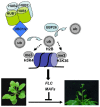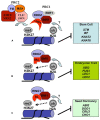Dynamic regulation and function of histone monoubiquitination in plants
- PMID: 24659991
- PMCID: PMC3952079
- DOI: 10.3389/fpls.2014.00083
Dynamic regulation and function of histone monoubiquitination in plants
Abstract
Polyubiquitin chain deposition on a target protein frequently leads to proteasome-mediated degradation whereas monoubiquitination modifies target protein property and function independent of proteolysis. Histone monoubiquitination occurs in chromatin and is in nowadays recognized as one critical type of epigenetic marks in eukaryotes. While H2A monoubiquitination (H2Aub1) is generally associated with transcription repression mediated by the Polycomb pathway, H2Bub1 is involved in transcription activation. H2Aub1 and H2Bub1 levels are dynamically regulated via deposition and removal by specific enzymes. We review knows and unknowns of dynamic regulation of H2Aub1 and H2Bub1 deposition and removal in plants and highlight the underlying crucial functions in gene transcription, cell proliferation/differentiation, and plant growth and development. We also discuss crosstalks existing between H2Aub1 or H2Bub1 and different histone methylations for an ample mechanistic understanding.
Keywords: Arabidopsis thaliana; chromatin; epigenetics; histone monoubiquitination; plant development; transcription regulation; ubiquitin.
Figures


Similar articles
-
Histone H2A monoubiquitination marks are targeted to specific sites by cohesin subunits in Arabidopsis.Nat Commun. 2023 Mar 3;14(1):1209. doi: 10.1038/s41467-023-36788-3. Nat Commun. 2023. PMID: 36869051 Free PMC article.
-
ZRF1 Chromatin Regulators Have Polycomb Silencing and Independent Roles in Development.Plant Physiol. 2016 Nov;172(3):1746-1759. doi: 10.1104/pp.16.00193. Epub 2016 Sep 14. Plant Physiol. 2016. PMID: 27630184 Free PMC article.
-
Histone H2B monoubiquitination: roles to play in human malignancy.Endocr Relat Cancer. 2015 Feb;22(1):T19-33. doi: 10.1530/ERC-14-0185. Epub 2014 Jun 2. Endocr Relat Cancer. 2015. PMID: 24891457 Review.
-
Histone H2B Monoubiquitination Mediated by HISTONE MONOUBIQUITINATION1 and HISTONE MONOUBIQUITINATION2 Is Involved in Anther Development by Regulating Tapetum Degradation-Related Genes in Rice.Plant Physiol. 2015 Aug;168(4):1389-405. doi: 10.1104/pp.114.256578. Epub 2015 Jul 4. Plant Physiol. 2015. PMID: 26143250 Free PMC article.
-
The polycomb complex PRC1: composition and function in plants.J Genet Genomics. 2013 May 20;40(5):231-8. doi: 10.1016/j.jgg.2012.12.005. Epub 2013 Jan 3. J Genet Genomics. 2013. PMID: 23706298 Review.
Cited by
-
The Ubiquitin System and Jasmonate Signaling.Plants (Basel). 2016 Jan 9;5(1):6. doi: 10.3390/plants5010006. Plants (Basel). 2016. PMID: 27135226 Free PMC article. Review.
-
Investigating Interactions Between Histone Modifying Enzymes and Transcription Factors in vivo by Fluorescence Resonance Energy Transfer.J Vis Exp. 2022 Oct 14;(188):10.3791/64656. doi: 10.3791/64656. J Vis Exp. 2022. PMID: 36314833 Free PMC article.
-
A Novel Epigenetic Regulator ZRF1: Insight into Its Functions in Plants.Genes (Basel). 2021 Aug 15;12(8):1245. doi: 10.3390/genes12081245. Genes (Basel). 2021. PMID: 34440419 Free PMC article. Review.
-
The histone deubiquitinase OTLD1 targets euchromatin to regulate plant growth.Sci Signal. 2016 Dec 20;9(459):ra125. doi: 10.1126/scisignal.aaf6767. Sci Signal. 2016. PMID: 27999174 Free PMC article.
-
Histone 2B monoubiquitination complex integrates transcript elongation with RNA processing at circadian clock and flowering regulators.Proc Natl Acad Sci U S A. 2019 Apr 16;116(16):8060-8069. doi: 10.1073/pnas.1806541116. Epub 2019 Mar 28. Proc Natl Acad Sci U S A. 2019. PMID: 30923114 Free PMC article.
References
-
- Berr A., McCallum E. J., Alioua A., Heintz D., Heitz T., Shen W.-H. (2010). Arabidopsis histone methyltransferase SET DOMAIN GROUP 8 mediates induction of the jasmonate/ethylene pathway genes in plant defense response to necrotrophic fungi. Plant Physiol. 154 1403–1414 10.1105/tpc.110.079962 - DOI - PMC - PubMed
Publication types
LinkOut - more resources
Full Text Sources
Other Literature Sources

